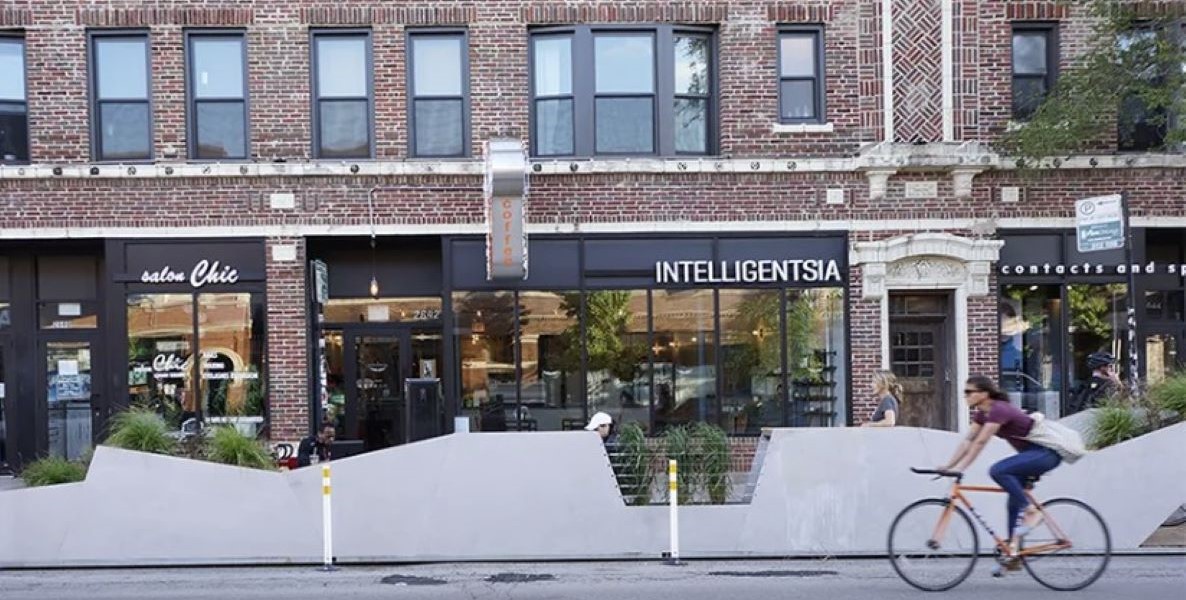The Covid pandemic permanently changed Philadelphia’s streetscape, as businesses, mostly restaurants, expanded outdoors onto sidewalks, public right of ways and parking spots. There are now more than 100 so-called “streeteries,” (also known as “streateries”) — dedicated, on-street extensions of dining and drinking spots, throughout the city.
But non-dining community spaces, especially seasonal mini-parks called parklets (so named because these pop-ups typically occupy two or more parking spaces), have disappeared, and interest in them has dwindled: This year, the City received only two requests for parklet permits, says Deputy Commissioner of Transportation Richard Montanez, whose office handles applications for parklets, bike corrals and pedestrian plazas, which are permanent, protected extensions of the sidewalk.
Why should Philly care about parklets? As our city continues to struggle to fill office buildings and retail spaces, as our country continues to hide behind screens to wage political and personal battles, parklets encourage people to linger outside, take a load off, patronize the businesses around them, and have civil, in-person interactions with strangers. Civil conversations, even.
“We’re taking away two parking spaces, which isn’t a lot, but we’re giving this space where people can sit outside and enjoy the neighborhood.” — John Collazzo, Fishtown Kensington Business Improvement District
“A lot of the parklets changed to streeteries,” Montanez says. “I think we need to find someone to work with community groups and show them how (parklets) can be done.”
Enter Ariel Ben-Amos, founder and director of StreetBoxPHL, an organization dedicated to helping neighbors find low-cost ways to improve their environments and increase pedestrian safety by making better use of public space, including 29 miles of city streets and sidewalks. This fall, StreetBoxPHL is launching the Right of Way (ROW) Roundtable, a group for “ROW stewards,” i.e. people, groups or organizations who take care of public spaces or want to create them on city streets and sidewalks.
Ben-Amos, who is also an urban planner with the Philadelphia Water Department and a Penn lecturer, says the Roundtable will have sessions on navigating bureaucracy and leveraging community resources, and will bring City staffers into virtual rooms to help interested community members better understand how to create the small spaces.
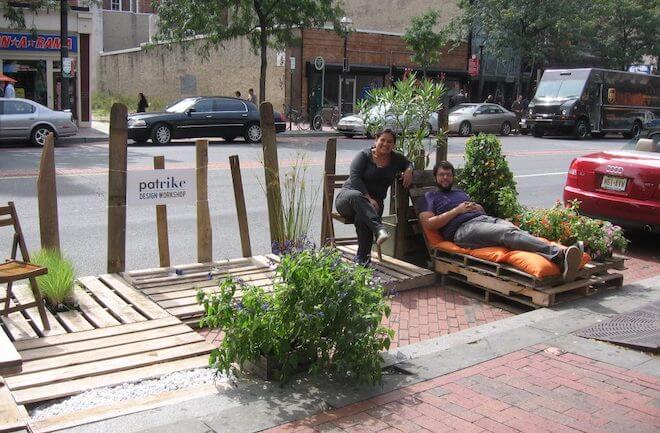
There’s a reason there are so few parklets, Ben-Amos says. The City’s existing guidelines contain costly, and unnecessary, requirements that could and should be eliminated. And there is not a lot of support for residents who might want to set up a small park in their neighborhood.
“We want to help everybody who wants to make sidewalks, streets and medians better for humans, whether it’s with parklets, pedestrian plazas, daylighting an intersection or something else entirely,” he says.
How Chicago does parklets
An example of a growing parklet program is in Chicago. Called People Spots, the installations are part of the Chicago Department of Transportation’s Make Way for People program, which aims to build community by supporting innovative use of the city’s streets, parking spaces, alleys and plazas.
The initiative launched in 2016, then knocked off-balance for about three years because of the pandemic, says Lubka Benak, CDOT’s Director of Liveable Streets. It’s still growing, with roughly 10 people spots up and running in a given year. There’s no limit to the number of People Spots available because “we don’t have enough,” she says.
Benak has two employees dedicated to the Make Way for People program. Part of their work is ensuring that Chicagoans know about People Spots, and understand how to set them up.
The process involves applying to CDOT, detailing how many 20-foot parking spaces it intends to use and agreeing to follow city People Spot guidelines, which include a platform, usually wood, that is roughly flush with the curb and wheelchair accessible. The spots are in place from May 1 until November 30.
“Now it’s like a tourist attraction,” Nardella says. “There’s a bustling community of bees and butterflies. Neighbors stop there to pick flowers on their way home.” — Marc Nardella, Moss
Because establishing a People Spot requires an investment of about $15,000, most of the Chicago installations are managed and maintained by neighborhood associations and business districts. Chicago also provides tips to help costs, including offering free, easy-to-follow designs for spot construction.
While the dollars spent are comparable to what a Philadelphia organization would spend on a parklet, the Chicago program is better established, and potential parklet sponsors know what they need to do to create and maintain one. Make Way for People is also supported by local nonprofits and business groups, including the Chicago Loop Alliance.
One of the benefits of the People Spot program, Benak says, is that it has created an ongoing conversation between the city and citizens. But it also has been a boon to businesses. According to a study by the Metropolitan Business Council several years ago, 80 percent of businesses near people spots said the parklets had brought in more foot traffic. Some said they led to a 10 to 20 percent increase in sales; 34 percent of users said they made unplanned food or beverage purposes.
“Now people are coming to the city with ideas for activating existing spaces and we’re going back and forth,” Benak says. “The pandemic showed people that outdoor space is important, and we need more of it.”
Architect Matt Nardella’s company, Moss, created a few of the first People Spots — and created their own a few years ago when they moved operations into an abandoned grocery store. Today, the formerly trash-filled lot is a permanent green space with four red oaks and other native perennials.
“Now it’s like a tourist attraction,” Nardella says. “There’s a bustling community of bees and butterflies. Neighbors stop there to pick flowers on their way home.”
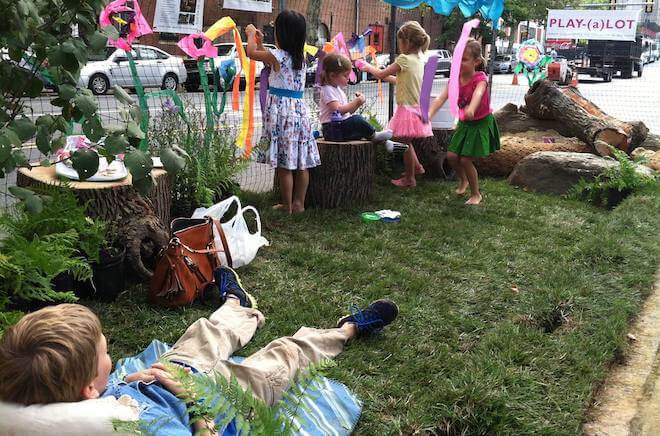
A national movement
Temporarily replacing parking spots with parks is an idea that many credit to San Francisco, which in 2005 held its first Park(ing) Day. A group of artists and designers wanted to change what they saw as the unequal division in the use of the right of way, with cars and trucks claiming about three-quarters of available space. The first parklet was a bit of sod with a bench and a potted tree in a single metered parking spot. It remained in place for two hours, and organizers fed the meter the entire time.
Minutes after the mini-park was installed, a man sat down on its bench, took off his shoes and ate a takeaway meal. A short time later, another person joined him, and the two began talking.
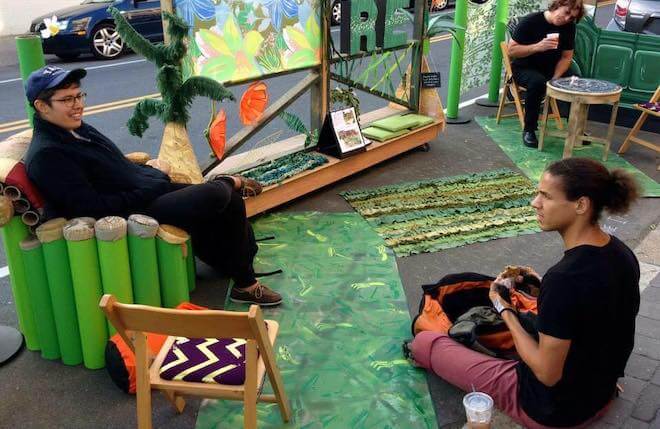
Park(ing) Day has gone national, held annually on the third Friday in September. For Philadelphia’s event, teams sign up with information about where they will be and what they plan to do. Organizers make a list of the parking spots that will be used, and send it to the Philadelphia Parking Authority, which waives parking costs.
Past participants have featured games, art-making stations, social gathering spaces, community engagement projects and educational opportunities. A spot can be as minimal as a single table and chairs or as ambitious as large planters, fake grass, and shelters or other unique structures. On the organizers’ website, it notes that on one (Park)ing Day, the “highlight was getting called losers by a nice man who had to park on the next block instead.”
A 2015 UCD white paper found that businesses located near parklets reported 20 percent increases in sales.
University City District (UCD) was an early supporter of local parklets. They set up their first in 2011. By 2017, UCD had six in its 2.5-mile area. These parklets stood near businesses, libraries and, in one case, a laundromat. They were open to all users.
“We had a lot of success,” says Nate Hommel, UCD’s Director of Planning and Design. “Over the years, we developed a number of different strategies to maintain them.” Those strategies included asking businesses to put out the parklet furniture in the morning and take it in at night. They also established Green City Works, a landscaping company that trains and employs local and underserved residents.
A 2015 UCD white paper found that businesses located near parklets reported 20 percent increases in sales. Southwest Philadelphia neighbors so loved its neighborhood parklet that they expanded it to include a Little Free Library to it. These weren’t “world-class gathering spaces,” Hommel says, but they were important to people.
Philadelphia established its guidelines for parklets more than a decade ago. Perhaps the most onerous existing requirement is that a parklet’s overseers remove and store the deck during the winter, the theory being that the parklets would adversely affect snow removal.
But streeteries have proven that we can leave structures in place year-round, first allowed because of the need for outdoor gathering spaces during the pandemic. When the City saw the structures did not adversely affect residents or businesses, it established streetery guidelines that said these non-permanent extensions could remain in place year round as long as they were maintained, inspected and licensed annually.
“The old fear was Oh my God, if people see a parklet covered in snow, they’ll say, ‘Why is that stupid thing there taking up our parking?’” says Hommel. “But the pandemic showed you could have streeteries out year round.”
Obstacles abound
Ben-Amos estimates the cost of building and installing a parklet falls between $10,000 to $30,000. Removing and storing them adds thousands to the cost.
Another obstacle? Insurance. That’s less of a problem for parklet seekers who partner with a business with applicable insurance, but what happens to parklets on residential streets or empty lots?
The parklet “may have significant community impact, but the sheer impact of getting insurance coverage will kill the project,” Ben-Amos says.
And before you ask: You can’t just replace a parklet with a streetery. The latter are for restaurants and have building and safety requirements that are more much extensive. Most of the streeteries that popped up during the pandemic did not comply with the current standards — and have since majorly revamped or were removed.
Montanez says the City is (at least theoretically) pro-parklet, and points to a mini-park on Woodland Avenue that began as a parklet as example. When the City decided to close that section of the street to traffic, the Streets Department “did some extra paving to help the parklet,” he says.
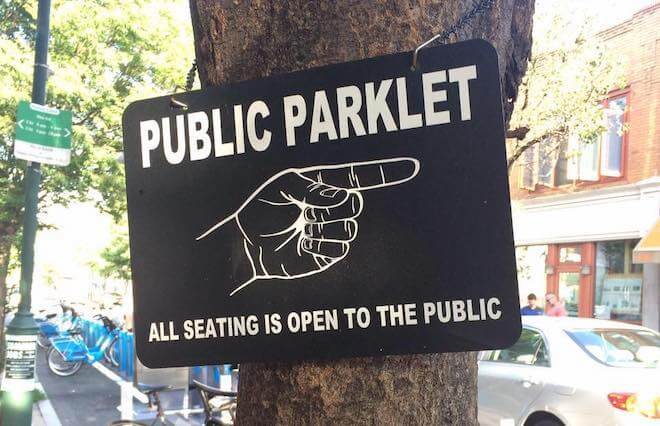
UCD no longer manages any parklets, in part because of the costs of the annual removal and replacement. (But Hommel says they’re just in storage and may see the streets again.) Instead, the organization is looking to add more pedestrian plazas, which are an extension of the sidewalk, marked by a painted white line and bracketed by safety bollards and planters.
Pedestrian plazas are more expensive to set up, which puts them out of reach of most small businesses and individuals. But they don’t require special decking — and, most importantly, they can stay up year-round.
Marc Collazzo, director of the Fishtown Kensington Business Improvement District, expects a new pedestrian plaza in the 1700 block of Front Street will be finished this fall. New construction in the area will soon bring new housing and commercial outlets to the area. Collazzo’s organization using a $75,000 grant to pay for the plaza.
“We’re creating something from nothing. Right now, it’s a road, basically, a street,” Collazzo says. “We’re taking away two parking spaces, which isn’t a lot, but we’re giving this space where people can sit outside and enjoy the neighborhood.”
![]()
MORE ON PUBLIC SPACES FROM THE PHILADELPHIA CITIZEN



